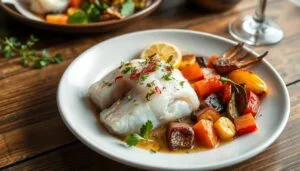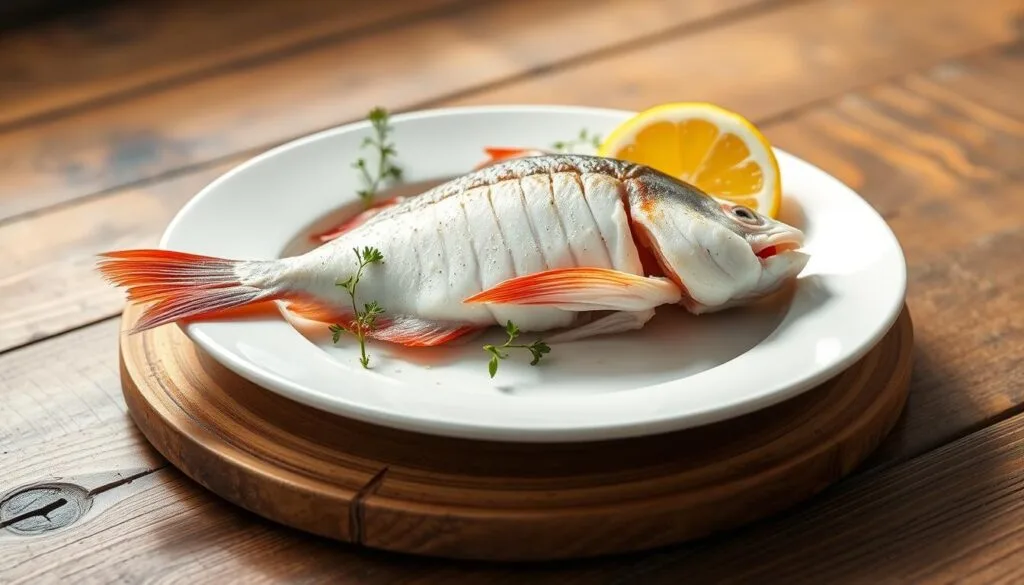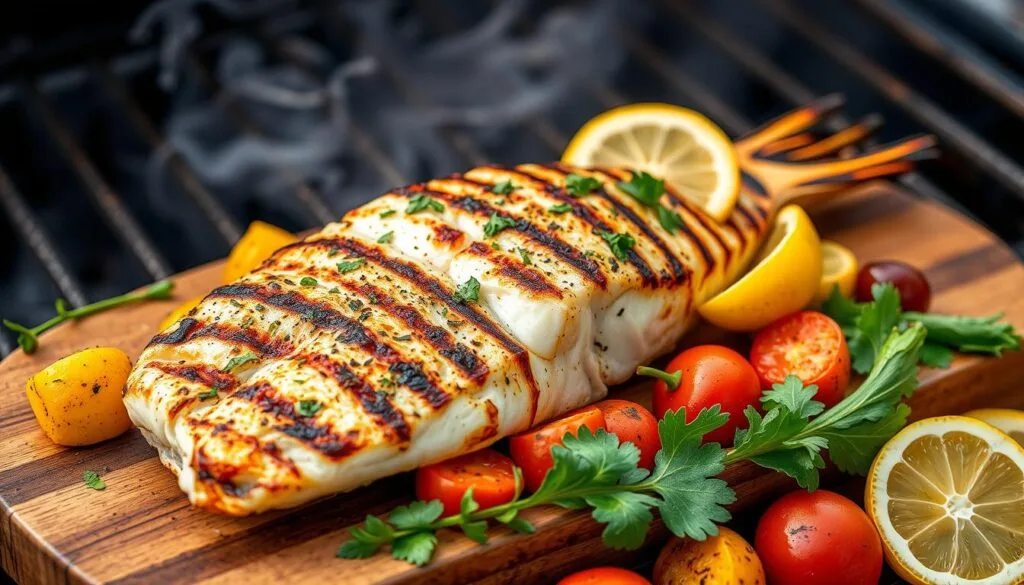The Best Fluffy Pancakes recipe you will fall in love with. Full of tips and tricks to help you make the best pancakes.

Walking through the farmer’s market, I saw a lot of fresh seafood. But the monkfish caught my eye. It’s called the “poor man’s lobster.” Its strange look and interesting story made me want to learn more.
Monkfish, or Lophius americanus, is a lean fish with white flesh. It tastes like a mix of the sea and forest. This fish was once ignored but now, chefs and home cooks love it for its unique taste.
Key Takeaways
- Monkfish, also known as the “poor man’s lobster,” is a unique and versatile seafood with a distinct flavor profile.
- The fish is characterized by its lean, white flesh and firm, almost meaty texture.
- fish is a good source of protein, B vitamins, and essential minerals like potassium and selenium.
- Proper preparation, including removing the membrane and following specific cleaning methods, is crucial for enjoying the full culinary potential of this seafood.
- Monkfish can be prepared in a variety of ways, from classic preparations to modern interpretations and international dishes, making it a versatile addition to any kitchen.
Understanding the Monk Fish: Nature’s Deep-Sea Predator
The fish, also known as the angler, is a fascinating marine creature. It lives deep in the world’s oceans. As a bottom-dweller, this ugly fish is a true deep-sea predator. It lurks in the shadows, using its unique characteristics to its advantage.
Physical Characteristics and Habitat
The fish, or Lophius, is easily recognizable. It has a large, gaping mouth and a distinctive fleshy growth on its head. These bottom-dwelling fish can grow quite large. The largest species, Lophius piscatorius, can reach up to 200 cm (79 inches) in length.
Monk fish live in various habitats. They can be found in shallow coastal waters and deep ocean depths. They range from just below the tide line to as far as 900 meters.
Why It’s Called the Sea Devil
The monk fish’s appearance and hunting behavior have earned it the nickname “sea devil.” This ugly fish uses its fleshy growth, known as an esca, to lure in prey. Once prey comes close, the monk fish’s large mouth opens wide to engulf it. This shows its fearsome and predatory nature.
Distribution and Natural Behavior
Monk fish are found worldwide, with major harvesting areas in the North Atlantic. The species Lophius piscatorius is common in the northeast Atlantic. Lophius americanus is found in the northwest Atlantic, and Lophius litulon in the northwest Pacific.
These bottom-dwellers have complex life cycles and reproductive strategies. Females usually grow larger than males. Their spawning grounds are specific, and their movements are influenced by prey and environmental factors.
“Monk fish are truly remarkable creatures, combining a unique appearance with an exceptional ability to thrive in the challenging deep-sea environment.”
The Unique Flavor Profile of Monk Fish
Monkfish is known as the “poor man’s lobster.” It has a sweet, earthy taste and a firm texture. This makes it a favorite among chefs and home cooks.
The meat of fish is very versatile. It can be cooked in many ways and pairs well with different flavors. Its texture is similar to scallops, making it great for fancy dishes.
Monk fishtails are the most used part of the fish. They weigh between 1 to 4 pounds. These tails come from the Atlantic and are known for being sustainable and of high quality.
| Flavor Profile | Texture | Versatility |
|---|---|---|
| Sweet, mildly earthy | Firm, dense, non-flaky | Holds up well to various cooking methods and flavors |
To keep monk fish fresh, handle and cook it carefully. Fresh fish can be stored in the fridge for up to 3 days. Frozen fish should thaw slowly in the fridge overnight for the best taste.
Monkfish is perfect for both classic and modern dishes. Its unique taste and texture make it a favorite in the culinary world.
Nutritional Benefits and Health Value
Monkfish is not just tasty; it’s also full of nutrients. This deep-sea fish is rich in vitamins, minerals, and healthy fats. These can greatly improve your health.
Protein and Vitamin Content
Monkfish is a great source of protein, with about 15.8 grams in every 3-ounce serving. This protein is good for building and repairing muscles. It’s perfect for those who are active or trying to stay fit.
Monkfish also has lots of B vitamins like niacin, vitamin B6, and vitamin B12. These vitamins help with energy, metabolism, and nerve health.
Omega-3 Fatty Acids
Monkfish has a good amount of omega-3 fatty acids. These fats are known to lower bad cholesterol and reduce heart disease risk. A study in the Tanaffos Journal backs this up.
Eating monkfish can help keep your heart healthy. It’s a great choice for a balanced diet.
Mineral Composition
Monkfish is also packed with important minerals. It has calcium, iron, magnesium, phosphorus, potassium, and selenium. These minerals are key for strong bones, a healthy immune system, and many body functions.
A report from the American Journal of Medicine shows monkfish’s calcium and phosphorus levels. These help keep your bones strong.
Monkfish is a lean white fish that’s great for a healthy seafood diet. Adding it to your meals can bring many health benefits. It supports your overall well-being.
Selection and Quality Tips for Fresh Monk Fish
When picking fresh monk fish, look for firm, white flesh. It should have no discoloration. The meat should smell mildly of the ocean, not strongly fishy.
If you’re buying whole fish, check the eyes. They should be clear and bulging, not sunken or cloudy. Store fresh monk fish in the coldest part of the fridge at 32 degrees. Keep it wrapped in paper towels to absorb moisture and firm up the fish.
Monkfish tail meats weigh from 1 to 4 pounds. This makes it great for many recipes. It’s a lean fish, high in protein and low in fat. Plus, it’s a sustainable choice from the Atlantic through Boston.
Monk fish has a firm texture and a mild, sweet flavor, like lobster. It’s often used in French cooking, poached in butter. You can also use halibut, cod, or sea bass as alternatives.
| Monk Fish Attributes | Value |
|---|---|
| Calories per 3-oz serving | 76 |
| Protein per 3-oz serving | 14 grams |
| Fat per 3-oz serving | 1 gram |
| Omega-3 Fatty Acids | Beneficial |
| Vitamin B12, Phosphorus, and Selenium | Rich in essential nutrients |
Monkfish is one of the more affordable seafood options, making it accessible and appealing to a wide range of consumers.

Choosing quality seafood like fresh monk fish is key for a great meal. Follow these tips to pick the best fish selection for your dishes.
Essential Preparation Techniques
Before cooking monkfish, it’s key to prepare it right. First, remove the blue-grey membrane that covers the flesh. This membrane gets tough and chewy when heated, so peel it off carefully. Then, clean the monkfish well, removing any scales you see.
Portioning Guidelines
The monkfish’s firm, almost boneless tail meat is easy to portion. When buying monkfish, get slightly larger fillets than you think you’ll need. The meat loses moisture and shrinks during cooking.
| Monkfish Preparation Tip | Recommendation |
|---|---|
| Fillet size | Buy slightly larger fillets than needed |
| Shrinkage during cooking | Monkfish meat can lose moisture and shrink |
| Membrane removal | Carefully peel off the blue-grey membrane |
| Cleaning | Thoroughly remove any visible scales |
By following these essential preparation techniques, you’ll ensure your monkfish is ready for delicious and flavorful cooking.
“Monkfish is a unique and versatile seafood that requires proper preparation to bring out its full potential.”
Popular Cooking Methods
Monkfish is a great choice for many cooking methods. Its firm texture makes it perfect for grilling, sautéing, or baking. It stays firm and doesn’t fall apart.
For a tasty pan-seared dish, sear monkfish fillets in a hot skillet. Use olive oil or butter, then bake them for a crispy outside and a juicy inside. Grilling monkfish is also delicious, especially when marinated with herbs, garlic, and lemon juice.
Baking is another good option. Monkfish’s texture holds up well to dry heat. Try roasting it with vegetables, white wine, and herbs for a flavorful dish. It’s also great in chowders, stews, and kebabs, showing its versatility.
| Cooking Method | Recommended Time | Tips |
|---|---|---|
| Pan-Frying | 5-6 minutes | Sear in hot pan with oil/butter, then finish in oven |
| Grilling | 5-6 minutes | Marinate first for added flavor |
| Baking | 5-6 minutes | Roast with vegetables, herbs, and white wine |
| Sautéing | 5-6 minutes | Cook in hot pan with oil or butter |
| Steaming | 5-6 minutes | Serves well in chowders and stews |
Choosing the right cooking method is key. Monkfish fillets of about 100g cook in 5-6 minutes. Let them rest for 5 minutes before serving to keep them juicy.

Monkfish is a versatile ingredient with a firm texture and mild flavor. Try different cooking methods and flavors to find your favorite way to enjoy it.
Monk Fish Recipe Ideas and Inspirations
Monk fish has a mild, firm texture. It’s great for many tasty seafood dishes. You can make everything from classic dishes to modern twists and dishes from around the world.
Classic Preparations
One favorite is Monk Fish with Lemon-Caper Sauce. It has seared monk fish topped with a tangy sauce. The sauce is made with lemon, capers, and butter. It’s a perfect mix of flavors that highlights the monk fish’s sweetness.
Modern Interpretations
For something new, try Monk Fish Coconut Curry. The monk fish soaks up the creamy coconut milk sauce. It’s a dish that’s both cozy and exotic.
International Dishes
Monk fish is great for international dishes too. Try Monk Fish en Papillote, a French dish. It’s baked in parchment with herbs and white wine. Or, make a Spanish Monk Fish Stew with tomato broth and bold spices.
Monk fish’s mild taste is perfect for many flavors and cooking ways. Whether you like traditional dishes or international flavors, monk fish is a great choice. It offers endless chances for tasty and memorable meals.
“Monk fish is a true chameleon in the kitchen, able to adapt to a wide variety of flavors and cooking techniques.”
Pairing Suggestions and Complementary Flavors
Monk fish pairs well with many ingredients because of its firm texture and sweet flavor. Classic sauces like beurre blanc and lemon-butter add richness. Creamy risotto also complements its taste.
Side dishes like mashed potatoes and roasted carrots enhance the monk fish’s flavor. Sautéed mushrooms and onions are also great choices. For wine, a crisp Sauvignon Blanc or a light Pinot Noir works well.
Try adding herbs and spices like thyme, parsley, and dill to your dish. They can make the monk fish taste even better. With a bit of creativity, you can make a memorable monk fish meal that everyone will love.









